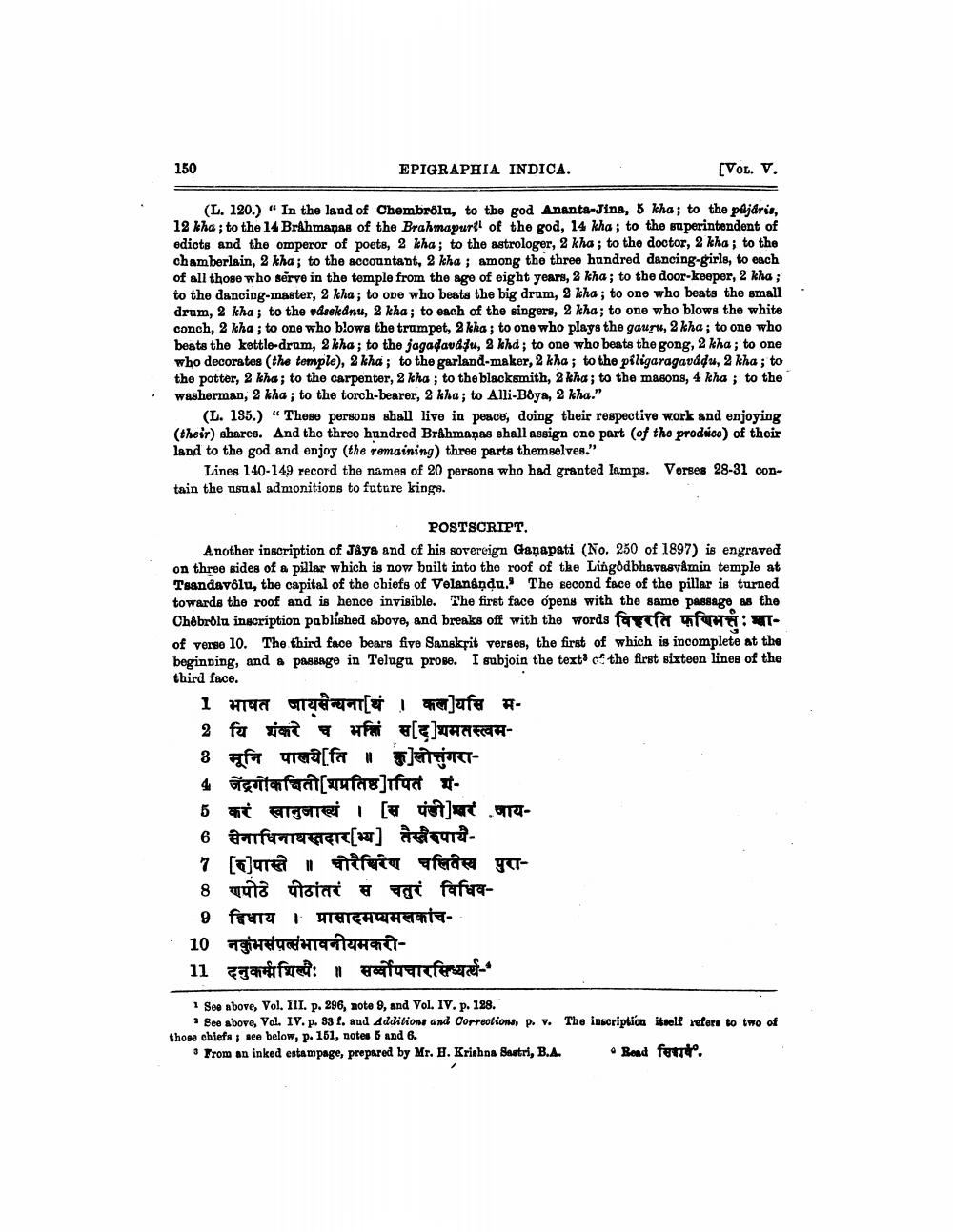________________
150
EPIGRAPHIA INDICA.
[Vol. V.
(L. 120.) "In the land of Chombrölu, to the god Ananta-Jina, kha; to the pájaris, 12 kha; to the 14 Brahmapas of the Brahmapuril of the god, 14 kha; to the superintendent of edicts and the omperor of poets, 2 kha; to the astrologer, 2 kha; to the doctor, 2 kha; to the chamberlain, 2 kha; to the accountant, 2 kha; among the three hundred dancing-girls, to each of all those who serve in the temple from the age of eight years, 2 kha; to the door-keeper, 2 kha ; to the dancing-master, 2 kha; to one who beata the big drum, 8 kcha; to one who beats the small drum, 2 kha; to the vdrelednu, 2 kha; to each of the singers, 2 kha; to one who blows the white conch, 2 kha; to one who blows the trampet, 2 kha; to one who plays the gausu, 2 kha; to one who beats the kettle-drum, 2 kha; to the jagadavdfu, 2 khd; to one who beats the gong, 2 kha; to one who decorates the temple), 2 kha; to the garland-maker, 2 kha; to the piligaragavadu, 2 kha; to the potter, 2 kha; to the carpenter, 2 kha ; to the blacksmith, 2 kha; to the masons, 4 kha; to the washerman, 2 kha; to the torch-bearer, 2 kha; to Alli-Boya, 2 kha."
(L. 135.) “These persons shall live in peace, doing their respective work and enjoying (their) shares. And the three hundred Brahmapas shall assign one part of the prodice) of their land to the god and enjoy (the remaining) three parts themselves."
Lines 140-149 record the names of 20 persons who had granted lamps. Vorses 28-31 contain the usual admonitions to future kinge.
POSTSCRIPT. Another inscription of Jaya and of his sovereign Ganapati (No. 250 of 1897) is engraved on three sides of a pillar which is now built into the roof of the Lingodbhavsevimin temple at Tsandavolu, the capital of the chiefs of Velanaņdu. The second face of the pillar is turned towards the roof and is hence invisible. The first face opens with the same passage as the Chebrdlu inscription published above, and breaks off with the words विहरति फणिभत्त:साof verse 10. The third face bears five Sanskrit verges, the first of which is incomplete at the beginning, and a passage in Telugu prose. I subjoin the text' e the first sixteen lines of the third face.
1 भाषत जायसैन्यनाथं । कलयसि म2 यि शंकर च भति सदथमतस्त्वम8 मूनि पालये[ति ॥ कुलोत्तुंगरा* जेंद्रगोंकक्षिती[शप्रतिष्ठापितं शं. 6 करं खानुजाख्यं । [स पंडीवर .जाय6 सेनाधिनाथस्तदार[भ्य] तैस्वैपाय7 [क]पास्ते ॥ चौरैचिरेण चलितेस्य पुरा8 णपीठे पीठांतरं स चतुरं विधिव
9 विधाय । प्रासादमप्यमलकांच. - 10 नकुंभसंपत्संभावनीयमकरी
11 दनुकम्मशिल्पैः । सर्बोपचारसिध्यय
1 See above, Vol. III. p. 296, note 9, and Vol. IV. p. 128.
* See above, Vol. IV. p. 99 f. and Additions and Corrections, P. v. The inscription itself refers to two of those chiefs see below, p. 151, notes 6 and 6.
* From an inked estampage, prepared by Mr. H. Krishna Sastri, B.A. Read fatit.




